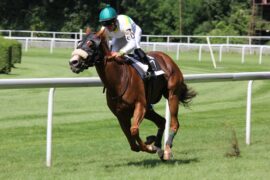York racecourse is nestled on the Knavesmire, just outside the city walls of York. This storied course is a tapestry of English history, changes in society, and architectural design. From Roman entertainment to modern Group-1 races, York has a rich racing history.
Today, it is a site that blends tradition and innovation, although it must still contend with weather changes, course maintenance, and the choices of trainers, including the ever-present concern of today’s non-runners in top meetings. Punters need to keep track of withdrawals, since a single favourite pulling out can change the market and trigger Rule 4 deductions. That’s why the top betting sites listing non-runners are so popular; they provide daily updates, non-runner bet guarantees, and clear terms.
The Start Of Racing At York
Racing at York goes back thousands of years. Historians believe the first equine contests occurred there in 208 AD, when Emperor Septimius Severus brought Arab horses to entertain his troops at the garrison known as Eboracum (now York).
Over the centuries, more formal records began to emerge. Horse racing is documented in York Corporation archives in the 1530s, and there is evidence of races held on the River Ouse (when it was frozen) between Skeldergate Postern and Micklegate Tower in 1607.
Races were held at Clifton Ings on the banks of the river in the early 18th century; however, frequent floods made it almost impossible to predict when a race would occur. Ultimately, the decision was made in 1731 to relocate the races to Knavesmire at the same site being used today. The first recorded meeting held there was a King’s Plate of 100 guineas (one guinea is worth at least £440 today) on 16 August 1731.
Knavesmire was public land back then, and required a lot of levelling, drainage of a stream, and reshaping the course to resemble a horseshoe. The first permanent structure erected was a grandstand in 1754 (or 1756, depending on who you ask). The grandstand was funded by patrons who paid five guineas each, and had a two-storey design with a rooftop for better viewing of the races. The ground floor had an entrance hall and arcade, while the upper level had a reception room and balcony.
York Race Committee
York’s racing fortunes had waned by the early 19th century. In an attempt to reestablish racing culture, a formal racing committee was established in 1842 to manage the course. The same body still runs the course today, operating under York Racecourse Knavesmire LLP.
Soon after the committee was formed, new featured races were introduced to raise prestige and attract crowds. The Ebor Handicap was founded in 1843; the Gimcrack Stakes in 1846. Around the same time, the course’s shape became circular.
Supporting infrastructure was gradually added. An enclosure was constructed by the grandstand, a weighing room added, and a Steward’s Stand built in 1851 (and replaced in 1853). By 1880, a polygonal Steward’s Stand was built next to the County Stand and Press Stand. By 1994, a Half Crown Stand was built next to the grandstand. The Committee approved a new Steward’s Stand in 1865, with boxes and retiring rooms. Many of those buildings still exist today as the Gimcrack Stand and Press Room, which were added in the early 20th century.
One of the historic highlights under committee stewardship was the match race of 1851. Volitgeur and The Flying Dutchman ran over two miles on the Knavesmire for 1,000 guineas a side. It was one of the most famous match races in British racing history.
Jump racing was briefly introduced between 1867 and 1885, but York has always been a predominantly flat racing venue. By the late 19th century, York was called “the Ascot of the North” and had officially reestablished itself as a pristine British racing venue.
Improvements To The Racecourse
The Committee had a longer lease in hand by 1907 (a 35-year lease), which encouraged them to start a program of architectural and infrastructural improvements. Architect Walter Brierley oversaw extensions and the construction of new stands between 1907 and 1913, including expansion to the County Stand (constructed 1867) and Press Stand (constructed 1875), as well as new stands.
The north end of the course was expanded, and the boundary was extended to allow a new wall, bars, an entrance gate, and a new weighing room built with classic red bricks.
During this period, the racing programme matured even more. The Yorkshire Cup was created, as well as the sprint that eventually became the Nunthorpe Stakes. The infrastructure at the racecourse was sophisticated by this time, meeting spectator expectations for quality races.
Post WWII
Racing was stopped during World War II when Knavesmire was a POW camp, and returned to York in 1945 with the Victory St Leger. The postwar years brought key races like the Lowther Stakes (1946), Dante Stakes (1958), and John Smith’s Cup (1960). Public interest led to more upgrades at the venue: a 1957 stand was replaced by the Melrose Stand (1989) and then the Knavemire Stand (1997).
York also hosted major events. Notably, Queen Elizabeth II attended the first Juddmonte International in 1972, and in 1982, more than 250,000 gathered for Pope John Paul II’s mass.
A New Millennium
The 2000s marked a new era of modernisation. Sunday racing debuted in 2000, evening meetings and music events followed suit, and the Ebor Stand opened in 2003. York successfully hosted the Royal Ascot in 2005 and also the St Leger the same year, proving it was finally a location for elite racing.
York Racecourse Today
York has embraced sustainability and innovation in recent years. The Bustardthrope End features a living roof, rainwater harvesting, and solar panels as part of the Green Knavesmire 300 initiative.
The Juddmonte International at York has a £1.25 million purse and was named the best race in the world in 2024, cementing York’s place as a premier global racing venue with a rich heritage and modern excellence.





